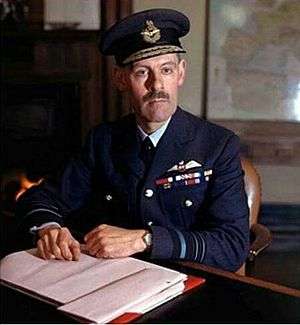Roderic Hill
| Sir Roderic Maxwell Hill | |
|---|---|
 | |
| Born | 1 March 1894 |
| Died | 6 October 1954 (aged 60) |
| Allegiance | United Kingdom |
| Service/branch |
British Army (1914–18) Royal Air Force (1918–48) |
| Years of service | 1914–48 |
| Rank | Air Chief Marshal |
| Commands held |
Fighter Command (1943–45) No. 12 Group (1943) RAF Staff College (1942–43) Palestine and Transjordan Command (1936–38) No. 45 Squadron (1924–25) |
| Battles/wars |
First World War Arab revolt in Palestine Second World War |
| Awards |
Knight Commander of the Order of the Bath Military Cross Air Force Cross & Bar Mentioned in Despatches (4) Commander of the Legion of Merit (United States) Grand Cross of the Order of the White Lion (Czechoslovakia) Commander of the Order of Leopold (Belgium) Croix de guerre (France) |
| Other work | Rector of Imperial College London (1948–53) |
Air Chief Marshal Sir Roderic Maxwell Hill, KCB, MC, AFC & Bar (1 March 1894 – 6 October 1954) was a senior Royal Air Force commander during the Second World War. He was a former Rector of Imperial College and Vice-Chancellor of London University.[1] The Department of Aeronautics of Imperial College is situated in a building named after him.
RAF career
Educated at University College, London, Hill joined the 18th Bn Royal Fusiliers as a private soldier in 1914 during the First World War and transferred to the Royal Flying Corps as a commissioned officer in 1916.[2] He took an interest in aircraft design and in 1917 became Officer Commanding the Experimental Section at the Royal Aircraft Establishment at Farnborough Airfield.[2] He was made Officer Commanding No. 45 Squadron in 1924[2] and flew Vernon transport aircraft on the Air Mail Route carrying British Government air-mail between Cairo and Baghdad, and made other air journeys in Iraq. He wrote and illustrated a memoir of his time in Iraq and the Middle East: it gives a lively account of flying the large biplanes of the period over difficult desert terrain, and also provides a sharply focussed, and sometimes lyrical description of the landscape and people of the region.[3]
He joined the Directing Staff at the RAF Staff College in 1927 and then went on to be the Officer Commanding the Oxford University Air Squadron in 1930, Deputy Director of Repair and Maintenance at the Air Ministry in 1932 and Air Officer Commanding Palestine & Transjordan Command in 1936.[2]
During the Second World War he was Director-General of Research and Development at the Air Ministry and then Commandant of the RAF Staff College from 1942.[2] He was appointed Air Officer Commanding No. 12 Group in 1943 and then served as Commander-in-Chief of Fighter Command (also briefly called the Air Defence of Great Britain during his command) from 1943 to 1945. Under his command the RAF was able to deal a bow to the German Luftwaffe's strategic bombing campaign during Operation Steinbock.[2]
After the war he was Air Member for Training and then Air Member for Technical Services before retiring in 1948.[2] In retirement he became Rector of Imperial College.[2] In 1953 he was nominated Vice-Chancellor of London University, before ill-health forced him to resign in the following year before completing his term of office.[1]
Personal life
Hill married Mabel Helen Catherine Morton in 1917. They had two daughters and an only son who was killed in action in 1944. He died from a coronary thrombosis near St Bartholomew's Hospital.[1]
See also
References
- 1 2 3 Denis Richards: Hill, Sir Roderic Maxwell (1894–1954), rev. Oxford Dictionary of National Biography, Oxford University Press, 2004; online edn, Jan 2011, accessed 28 Dec 2012
- 1 2 3 4 5 6 7 8 Air of Authority – A History of RAF Organisation – Air Chief Marshal Sir Roderic Hill
- ↑ The Baghdad Air Mail, Edward Arnold and Co, London, 1929.
External links
| Wikimedia Commons has media related to Roderic Hill. |
| Military offices | ||
|---|---|---|
| Preceded by John Andrews |
Air Officer Commanding No. 12 Group 1943 |
Succeeded by Malcolm Henderson |
| Preceded by Sir Trafford Leigh-Mallory |
Commander-in-Chief Fighter Command 1943–1945 |
Succeeded by Sir James Robb |
| Preceded by Sir Peter Drummond |
Air Member for Training 1945–1946 |
Post abolished Duties transferred to the Assistant Chief of the Air Staff (Training) |
| Academic offices | ||
| Preceded by Richard Southwell |
Rector of Imperial College London 1948–1953 |
Succeeded by Patrick Linstead |
| Preceded by Hugh Hale Bellot |
Vice-Chancellor of the University of London 1953–54 |
Succeeded by Sir John Lockwood |